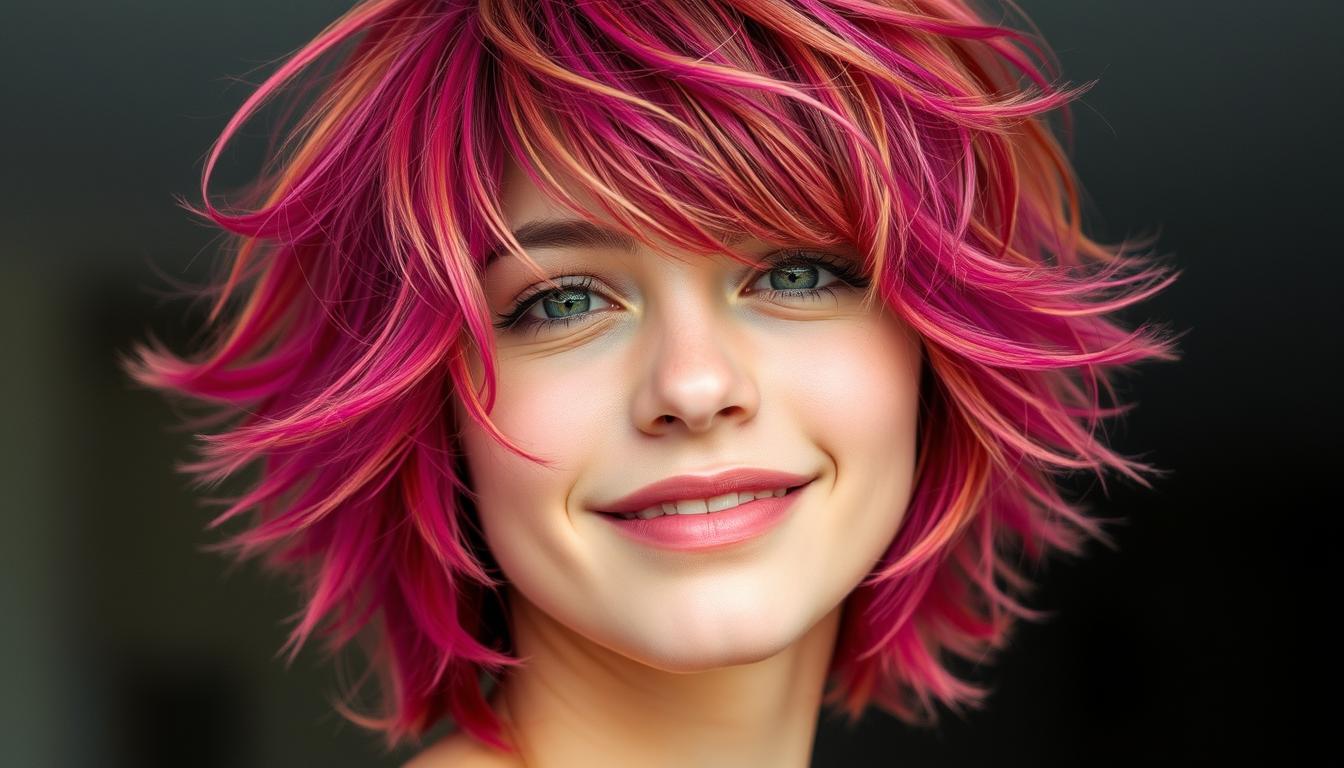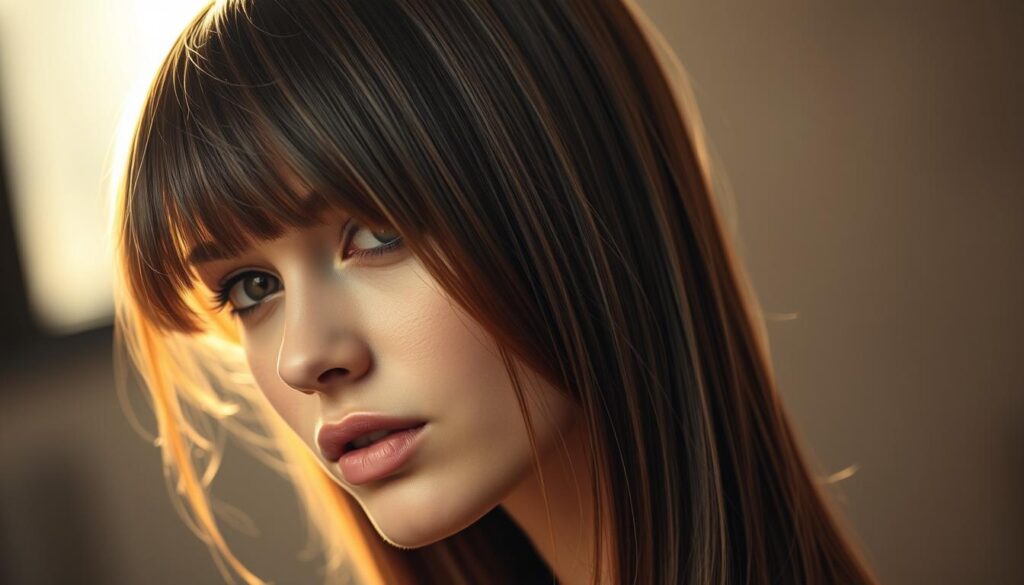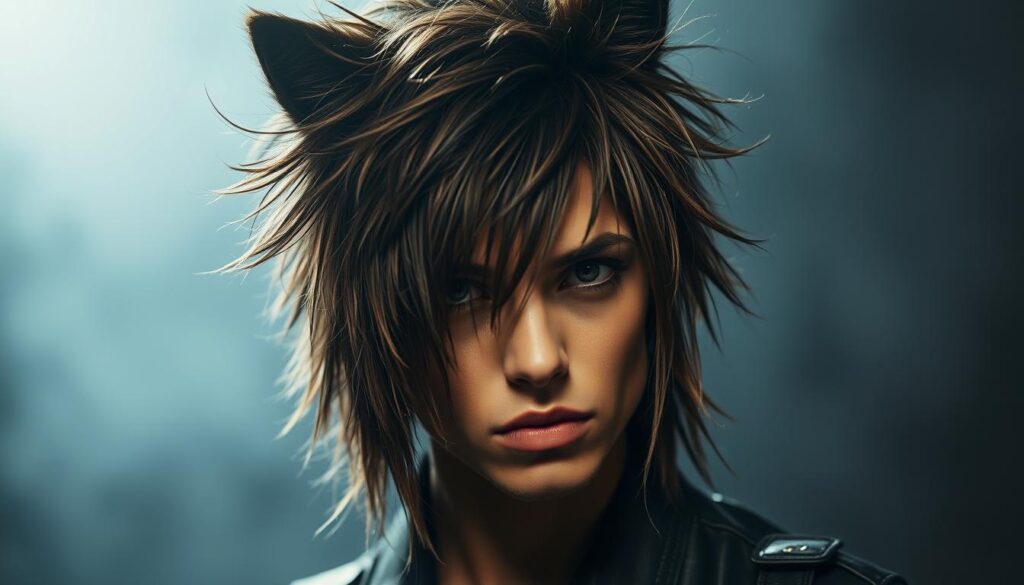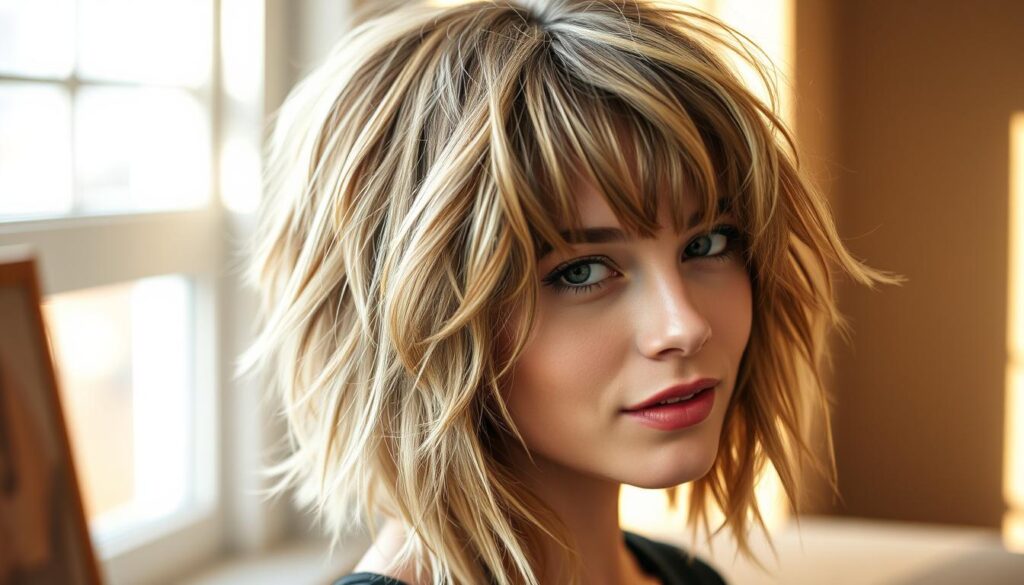
Ready for a low-fuss update with big personality? The classic shag blends layered texture and forward-worn lengths to add instant movement and a cool, rock ’n’ roll vibe without heavy upkeep.
The look rose to fame in 1970s music culture with icons like Mick Jagger and later Stevie Nicks. Today the shag returns in modern forms that suit many hair types and face shapes.
Why it’s trending now: Stylists say this style is adaptable and easy to personalize with bangs, color, or a shorter bob version. A light texture spray and a rough-dry approach give airy volume and lived-in texture with minimal effort.
If you want a fresh, wearable style that still reads edgy, this guide is for you. You’ll find ideas from 70s-inspired cuts to softer, modern takes, tips for talking to your stylist, and simple maintenance moves for lasting shape.
Key Takeaways
- The shag is a layered, forward-worn style that adds movement and texture.
- It works across many hair types and face shapes and is easy to personalize.
- Use a light texture spray and rough-dry styling for airy volume.
- Bangs and choppy layers define the overall shape and attitude.
- This guide covers variations from shaggy bob to soft modern looks and care tips.
What is a shag haircut? The rock ’n’ roll layers, fringe, and texture explained
This cut is built to fall toward the face, creating soft framing and lived-in movement. Think forward-falling lengths with intentional unevenness that gives a relaxed, modern edge.
Key features:
- Choppy layers at the crown and through mids and ends add lift and swing without looking styled.
- The shortest lengths sit in the fringe area so the hair leans forward and naturally frames the face.
- Uneven, textured cuts produce airy separation rather than a polished, uniform finish.
“The design builds volume without bulk by removing weight internally, so movement reads effortless.”
Unlike standard layered cuts that aim for smooth uniformity, this style celebrates imperfect texture and rock ’n’ roll attitude. Air-drying or using a diffuser enhances the lived-in finish. The same principles suit many hair types and face shapes, with bangs and fringe variations letting you dial in the exact shape and personality you want.
Who the shag suits right now: face shapes and hair types
Choosing the right layered look depends on how you want to balance your face and boost natural texture.
Customization is key. The curved, softly rounded silhouette of this cut softens sharp jaws and cheekbones on angular faces. Forward face-framing layers help visually shorten a long face.
Face shapes: balance and framing
For round or wide faces, start layers below the widest point and skip a heavy full fringe so the shape stays open. For long faces, shorter, face-forward pieces create the illusion of width.
Match fringe length and type to your proportions so the result frames rather than overwhelms.
Hair types: texture and volume
Wavy hair practically makes itself; layers amplify movement and a lived-in texture. Curls shine in this design when shaped to add structured volume and avoid a triangle silhouette.
Straight, very flat hair can work, but expect root-lift and texturizing support from styling and lightweight products. Fine hair benefits from airy layers to fake fullness, while thick hair often needs debulking for better swing.
Pro tip: The shag haircut work principle is simple — tweak density, layer length, and bangs to fit your face and hair types. For a related comparison, see wolf cut vs shag.
Classic shag: the 70s icon with choppy layers and bangs
Rooted in 70s rock culture, the classic shag pairs choppy tiers with a bold fringe for an undone, rebellious vibe.
The original design places the shortest lengths at the fringe and moves progressively longer toward the nape. This forward-worn layout frames the face and keeps movement focused around the eyes and cheekbones.
The cut delivers chunky layers and tousled texture that read casual and lived-in. It adds real volume to wavy hair and gives straight hair extra edge when finished with rough-dry styling.
Small modern tweaks—softer bangs, subtle lived-in highlights, or trimmed layer ends—update the look without losing its signature silhouette.
Why it works today: the design enhances natural flow, so busy mornings need only a lightweight mousse and a quick diffuse-dry to build body and keep that undone finish intact.
- Choppy layers create movement around the face.
- Fringe accuracy is essential—shag bangs make the cut feel iconic.
- Try a related modern edge with a comparison like wolf cut short hair.
Modern shag: softer edges, highlights, and wearable movement

Contemporary versions trade chunky tiers for gentle transitions and face-brightening highlights.
The modern shag is a softer, more blended evolution that still honors the forward-fringe architecture. It leans on smoother layer transitions for a relaxed, office-friendly vibe while keeping lively texture at the ends.
Dimensional color to enhance texture
Subtle balayage or face-framing highlights lift layers and make movement more visible. Color adds depth so each piece reads with separation and shine.
- Choose shoulder-grazing or longer lengths to fit your routine—both adapt well.
- Use a light cream on mids and ends to define texture without flattening roots.
- A softly snipped fringe or curtain variation updates the look without going full retro.
| Feature | Benefit | Maintenance |
|---|---|---|
| Soft layer transitions | Wearable movement, less styling time | Trim every 8–12 weeks |
| Dimensional color | Enhances texture and visual depth | Gloss or toner every 8–10 weeks |
| Light cream on mids/ends | Defines separation, keeps lift at roots | Daily styling, minimal heat |
Keep it simple: modest trims and color touch-ups preserve airy movement and the worn-in finish that makes this style so versatile for different face shapes and wavy hair types.
Curly shag with bangs: shape, volume, and defined curls
Tailored layering unlocks curl definition while giving the whole shape balanced volume.
Curly hair responds best when layers remove bulk and create a tidy frame. Stylists thin and sculpt the interior to keep weight off the ends. That builds a lively, face-forward silhouette that celebrates natural texture.
- Diffuser drying: preserves curl pattern and boosts volume with minimal frizz.
- Creams or balms: help clump curls and tame flyaways on medium-to-coarse textures.
- Fringe accuracy: a carefully cut bangs line opens the face and highlights eyes and cheekbones.
- Curl-by-curl detailing: ask your stylist to shape front pieces for seamless grow-out and easy day-two refreshes.
- Hydration and scrunch: gentle scrunching keeps the look bouncy and defined between washes.
“A precise front and soft internal thinning are the small moves that make curly shags sing,”
If you want a playful, low-fuss style, mention curly shag bangs to your stylist and request spring-length shaping that follows your curl pattern. Proper layering and simple styling make this look both modern and manageable.
Straight hair shag: sleek lines with edge

Sleek, straight textures can turn the layered look into something sharp and modern.
Very flat or straight hair wears this design well with a little styling support. Rough-dry without a fixed part to encourage root lift, then add a soft bend on mids and ends with a curling or flat iron.
Micro-choppy layers keep the perimeter full while giving movement and swing. A soft or curtain bangs adds interest at the brow without upsetting the sleek silhouette.
- Rough-dry first — no strict parting for natural lift.
- Define mids/ends with heat for piecey separation.
- Finish with a lightweight texture spray to build volume and hold.
| Feature | Why it works | How to do it |
|---|---|---|
| Micro-choppy layers | Adds movement without thinning perimeter | Ask stylist for short internal layers; trim every 8–12 weeks |
| Heat-defined mids/ends | Creates crisp pieces and subtle bend | Use a flat iron or small-barrel curler on low heat |
| Light texture spray finish | Builds body, avoids limp shine | Spritz mid-lengths and scrunch lightly |
Keep product minimal. Heavy oils flatten texture, so focus on airy lift and precise cuts. For inspiration, compare this approach to a related modern edge like the wolf cut medium hair.
Shaggy bob and wavy lob: shoulder-skimming texture
A shoulder-length lob with textured layers offers an easy, modern update. It gives a beachy vibe that works whether you air-dry or use a quick tool to shape ends.
Internal layers add lift at the crown and keep the classic bob outline neat. This prevents a heavy bottom line while giving natural volume and movement.
For wavy hair, this length pairs perfectly with an air-dry routine and a touch of sea-salt spray to emphasize undone texture. Light face-framing pieces or a soft bangs line brighten the eyes and balance proportions.
The look is versatile: smooth and polished for the office, tousled and casual for weekends. A few quick styling steps—rough-dry, bend the mids and ends, finish with a light mist—are all you need to switch moods.
- Lift without bulk: internal layers create volume but keep the bob’s clean edge.
- Workable length: shoulder-skimming length suits many face shapes and routines.
- Quick styling: air-dry plus salt-based product equals lived-in texture fast.
Wolf cut energy: a shag-meets-mullet moment

A wolf cut fuses high-contrast top layers with longer lengths at the back for a bold, modern silhouette.
What it is: This style blends a textured shag approach and mullet proportions. The result is choppy, statement layers up top and length left through the back.
The vibe is intentionally mussed and directional — a fashion-forward look that reads rebellious without being fussy.
- Anchor the face with a strong fringe or shag bangs to boost attitude.
- Rough-dry or diffuse to lift the crown, then piece out ends with a lightweight product for separation and shine.
- Wavy hair adapts instantly; straight hair benefits from added bend on mids and ends for extra texture and volume.
“Celebrities like Miley Cyrus helped bring this energetic mix into mainstream style.”
| Feature | Why it works | Styling tip |
|---|---|---|
| High-contrast layers | Adds movement and edge | Diffuse for crown lift |
| Longer back | Creates forward momentum | Decide length with stylist |
| Statement bangs | Centers the face | Trim to preferred boldness |
Pro tip: Tell your stylist how dramatic you want top fullness and back length. Clear communication prevents surprises and ensures the cut fits your daily routine.
Fine hair-friendly shag: lightweight layers that boost body
If your strands are on the finer side, subtle layering can create a fuller, more buoyant silhouette.
Strategically placed, lightweight layers add the illusion of thickness by creating movement and separation. Short internal pieces lift the crown while keeping the perimeter looking dense.
Styling tip: Work a volumizing mousse from roots to mids for natural lift without stiffness. Use a soft gel sparingly if you need extra hold on humid days.
Consider a soft fringe or gentle face-framing pieces to draw the eye upward. This adds interest around the face without sacrificing density at the ends.
- Keep texturizing conservative so ends don’t look stringy.
- Dry upside down or rough-dry at the roots for instant volume.
- Trim every 6–8 weeks to preserve the buoyant silhouette.
Want tailored guidance? For a related men’s take, see a concise guide to the shag haircut for men.
Thick hair shag: debulking layers for airy volume

Dense textures need more than surface snips — strategic debulking creates light, lively motion.
Interior thinning and choppy layers remove hidden weight so the perimeter stays soft instead of bulky. This gives the cut airy swing and visible separation through mids and ends.
Ask your stylist for controlled density removal. A medium fringe helps balance fullness and draws the eye to the face without adding heaviness.
Diffuse-drying boosts texture and shows off separated pieces. Skip heavy oils that collapse lift; choose lightweight creams or texture sprays for body and hold.
- Debulk inside the cut to keep a clean outline.
- Choppy outer layers create movement without bulk.
- Slightly longer back sections help proportion very dense hair.
| Technique | Benefit | When to use |
|---|---|---|
| Interior debulking | Reduces weight, adds swing | Dense, heavy hair |
| Choppy layering | Creates visible separation | Want textured mids and ends |
| Diffuser drying | Enhances volume and texture | After wash on damp hair |
Pro tip: Have your stylist tailor layer length and how much density they remove. Proper balance prevents a triangular outline and keeps the style light and wearable.
Fringe that frames the face: curtain, baby bangs, and full shag bangs
The fringe defines whether a layered cut reads soft and wearable or bold and editorial. A precise front line is the linchpin of this look—get the bangs wrong and the whole design loses its identity.
Curtain bangs for flow and face-framing
Curtain bangs offer gentle movement and easy grow-out. They part naturally and highlight cheekbones without demanding daily upkeep.
Choose a longer, tapered curtain if you want a forgiving option that suits many face shapes and wavy hair routines.
Baby bangs for bold shape
Baby bangs create an editorial, modern finish. Short and blunt, they draw attention to brows and eyes and instantly modernize the look.
These are high-commitment—discuss maintenance and lifestyle with your stylist before choosing them.
Full, choppy fringe for true shag attitude
Full, choppy fringe delivers rock-ready energy and a forward face focus. Jagged, textured edges keep the style lived-in and expressive.
For curly shag bangs, cut to spring length and shape each curl to maintain bounce and avoid a heavy band across the brow.
- Fringe is the mood-setter: soft or graphic depends on cut and texture.
- Match width and length to face shapes to avoid overwhelming softer features.
- Always book a salon consultation that covers lifestyle, upkeep, and styling needs before committing.
How to style a shag today: easy routines for texture and volume

Rough-dry first to wake up natural movement, then refine with light heat where you want definition. This gives the layers memory and makes shaping easier without overworking the hair.
Air-dry and diffuse methods for movement
Start with a gentle squeeze of cream or a light mousse through damp lengths. Rough-dry with your hands until hair is about 70–80% dry.
Use a diffuser on low to medium for wavy hair and curls to boost volume and enhance texture without frizz.
Root lift and parting tips for shape
Don’t worry about a perfect part early on. Set the root direction while the hair still has memory, then lightly finger-part for a flattering shape that frames the face.
Heat tools for definition on mids and ends
Add subtle bends with a small-barrel iron on mids and ends to define pieces. Keep heat low and work in short bursts so the look stays lived-in rather than polished.
Quick checklist:
- Rough-dry to create lift, then set a soft part.
- Diffuse on low for volume on wavy or curly textures.
- Mousse or gel for fine hair; creams or balms for coarser curls.
- Warm iron to shape mids/ends; finish with a texture spray, not heavy oils.
- Pro tip: braid damp hair overnight for effortless morning movement.
“A fast rough-dry gives the best base — it keeps the style airy and real.”
For DIY inspiration on playful, layered edits that work with this styling approach, check a concise guide like wolf cut DIY.
Product picks that enhance a shag: sprays, creams, and mousse
Pick lightweight styling tools and targeted products to boost natural lift without masking texture.
Start simple: choose formulas that add body at the roots and separation at the ends. Heavy oils flatten layered looks; texturizing sprays typically complement this cut better.
Texture and sea salt sprays for body
Sea salt and texture sprays create that beachy, airy body. SACHAJUAN Ocean Mist is a reliable pick to enhance movement without stiffness.
Volumizing sprays and mousses for lift
Root-lift heroes like Color Wow Raise the Root and K18 AstroLift give instant crown volume. Use a mousse on fine hair to build lift through the layers without crunch.
Creams and balms for curl definition
Creams and balms tame frizz and keep curls defined while preserving swing. For drying, the PATTERN Blow Dryer with a diffuser locks in wave and volume.
| Product Type | Example | Why to use |
|---|---|---|
| Sea salt spray | SACHAJUAN Ocean Mist | Adds airy texture and separation |
| Root-lift spray | Color Wow Raise the Root / K18 AstroLift | Instant volume at crown, boosts layers |
| Mousse | Lightweight volumizing mousse | Builds body without stiffness on fine hair |
| Creams & balms | Curl-defining cream or balm | Defines curls, controls frizz, preserves movement |
Quick tips: patch-test new items, favor lightweight formulas, and pair a diffuser tool to lock in shape. For more layered inspiration, see a related take on the wolf haircut long hair.
Maintenance that keeps your shag sharp: trims and timing
Regular, light maintenance keeps the shape lively and prevents lower lengths from weighing the style down.
Trim cadence: Book a trim every 6–8 weeks to preserve the layered structure and lively texture. Short, frequent visits stop the cut from getting uneven and make daily styling easier.
Dusting the ends between full trims removes bulk at the bottom and keeps movement through the layers. A quick salon dust is faster and less drastic than a full reshape.
Mini touch-ups to bangs are a smart move if you want visibility and crisp framing between visits. These small trims keep the front looking intentional without changing the overall cut.
- Wash less: Stretch washing and embrace air-dry or diffusing to protect texture and extend the time between salon trips.
- Keep a styling log: Note which products and methods worked so your stylist can refine density removal and layer placement.
- Consistency pays off: A steady shape means faster, predictable styling day to day.
“Small, regular steps keep the cut fresh and make your morning routine simpler.”
For timing ideas across different cuts, consider checking related scheduling info like fade types to compare maintenance rhythms.
Salon game plan: getting the fringe right and tailoring to your face
Before you sit in the chair, map out how you want the front to move and which brow line you want framed. Stylists Erin Powers and Kari Bennett both stress that if the bangs are off, it won’t read like a true shag. A focused consultation avoids that gamble.
Bring images, show your daily part, explain how much time you spend on styling, and say whether you favor air-dry or heat finish. This helps the stylist match layers, density, and the exact fringe width that suits your face.
Discuss face shapes and pick curtain versus full fringe based on how you want the face to read. Ask about density removal methods — point cutting, slide cutting, or razor work — so movement comes without frizz. Use the phrase shag haircut work to explain why a specific approach fits your texture.
| Consultation Topic | What to Share | Stylist Action |
|---|---|---|
| Part & Routine | Where you part, daily finish | Set root direction, plan layers |
| Fringe Details | Length, width, density | Cut precise bangs, show grow-out plan |
| Texture & Types | Your hair types and products | Select thinning method and at-home tips |
| Maintenance | Trim cadence, time for styling | Agree on fringe trims and tweaks |
“If bangs are off, it’s not a shag.”
Conclusion
This timeless, textured style adapts to any routine and nearly every hair type. It reads low-fuss but full of personality, whether you favor a softer, shag soft finish or something edgier.
Pick a fringe that flatters your features and fits daily life. Rough-dry, diffuse for lift, and choose lightweight products to keep movement alive. Small steps yield big payoff.
Keep trims on schedule so the shag cut grows out cleanly. Then bring your photos and questions to a trusted stylist to tailor the look to your face.
Take your favorite variation—classic, bob, or wolf—and make this hairstyle truly yours.
